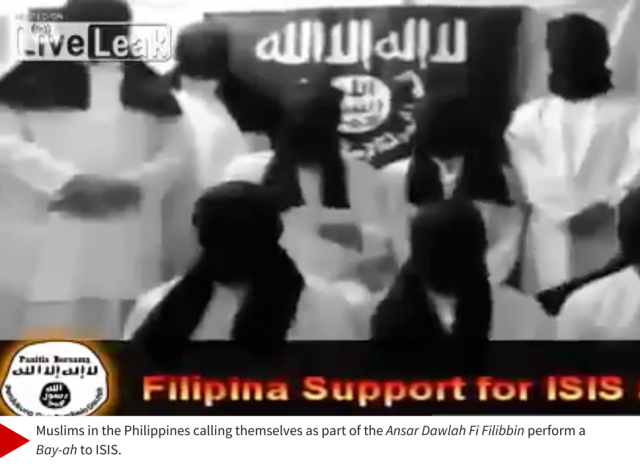Self-proclaimed ISIS Followers in the Bangsamoro Homeland: Threats to Philippine Security
- Details
- Blog Content
- Hits: 6448

Despite a repeated Philippine government denial, security threats emanating from the Islamic State of Iraq and Syria (ISIS) are real rather than imagined. ISIS has significant self-proclaimed followers in the Philippines as indicated by several violent groups that have arguably pledged allegiance and loyalty to its recognized Caliph, Abu Bakr al-Baghdadi.
When Baghdadi declared himself on 29 June 2014 as the Caliph of ISIS, or what its Muslim followers worldwide call as Al-Dawlah Al-Islamiyah Fi Al-Iraq Wa-Al Sham, some Muslim groups in the Philippines performed a Bay-ah or an oath of allegiance to ISIS.
Below are just some of the self-proclaimed followers of ISIS in the Philippines. These followers should be closely monitored as their thoughts and actions can present clear and present danger to Philippine security. Though these self-proclaimed ISIS followers operate mainly in the Bangsamoro Homeland in Mindanao, their intention and capabilities to carry out violent activities have tremendous repercussions for the security of the whole country.
The Ansar Dawlah Fi Filibbin
As early as May 2014, Muslims in the Philippines, who called themselves part of the Ansar Dawlah Fi Filibbin, posted a video on YouTube showing a few men in white dress performing a Bay-ah to Baghdadi using the ISIS black flag as the backdrop. Entitled “Filipina Support for ISIS and Bay-at to Shaikh Abu Bakar Al Baghdady (Hafidzahullah),” the video displayed a few men speaking in Arabic to express their support for and loyalty to ISIS and its leader Baghdadi. In the latter part of the video, these men spoke in Filipino, reiterating their allegiance to ISIS and full submission to Baghdadi.
The Rajah Solaiman Islamic Movement
On 7 July 2014, another video appeared on some Internet sites showing Muslim detainees in the Philippines performing the same Bay-ah to Baghdadi while displaying the ISIS black flag. The detention area appeared to be the Special Intensive Care Area (SICA) of the Bureau of Jail Management and Penology in Camp Bagong Diwa, Taguig City. SICA is known to be a “high risk” detention facility detaining suspected “high risk” personalities associated with the Abu Sayyaf Group (ASG), Jemaah Islamiyah (JI), Moro Islamic Liberation Front (MILF), Moro National Liberation Front (MNLF) and even the New People’s Army (NPA), the Alex Boncayao Group (ABG) and drug syndicates. SICA was the scene of the controversial “Bicutan Siege” of May 2005, which resulted in the gruesome death of infamous ASG leaders involved in the internationally renowned 2000 Sipadan Kidnapping: Commander Robot (Galib Andang), Commander Kosovo (Alhamser Limbong), and Commander Global (Nadzmi Sabdullah).
The video in SICA prompted suspicion that Ahmad Santos may have organized the activity. Santos was known to be the founder of the Rajah Solaiman Islamic Movement (RSIM), a militant organization of Muslim converts in the Philippines. On 4 June 2008, the United Nations (UN) Security Council added the RSIM and eight of its key officials to the UN 1267 Committee’s Consolidated List of individuals and entities affiliated with al-Qaeda (AQ), the Taliban, or Osama Bin Laden (UBL).
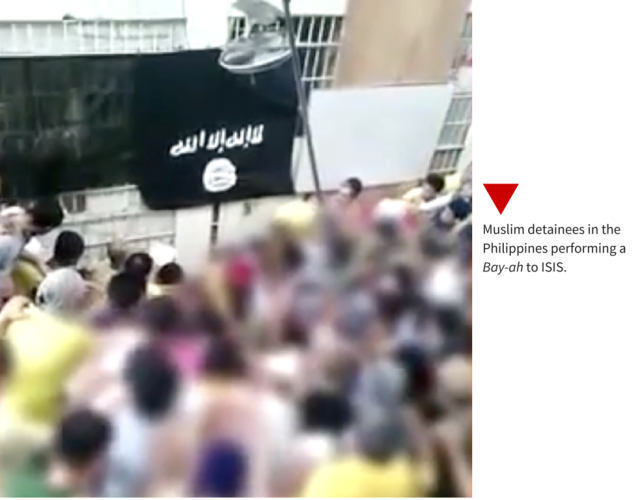
The Philippine government declared the RSIM as a dormant terrorist group because of the arrest of its key leaders. However, the RSIM continues to operate in Philippine prison facilities. In fact, Santos has been actively involved in militant activities inside the jail. Santos is also being suspected of leading the translation in Filipino of an Al-Qaeda doctrine on “Muslim Prisoners of War.” On 30 January 2015, the Australian Federal Police made an intelligence report linking Santos with an Australian national identified as Gerald John Sevidal being suspected by Australian authorities as a follower of ISIS.
The Jamaal al-Tawhid Wal Jihad Philippines
Santos’ links with ISIS followers were also established by his brother-in-law, Dinno Amor R. Pareja, a key RSIM official. Pareja was suspected to be the Abu Jihad Khair Rahman Al-Luzuni who posted a video on 6 November 2012 calling on Muslims in the Philippines to join the jihad. In this video, Pareja used the black flag of ISIS as his backdrop. This video proved that as early as 2012, ISIS ideological influences already reached the Philippines. Apparent from this video was the use of a movement called Jamaal al-Tawhid Wal Jihad Philippines. Interestingly, the Jamaal al-Tawhid Wal Jihad was the movement founded by Abu Musab Al-Zarqawi, the founder of Al-Qaeda in Iraq, the forerunner of ISIS. Thus, ISIS ideological influences in the Philippines predate its current international notorieties.
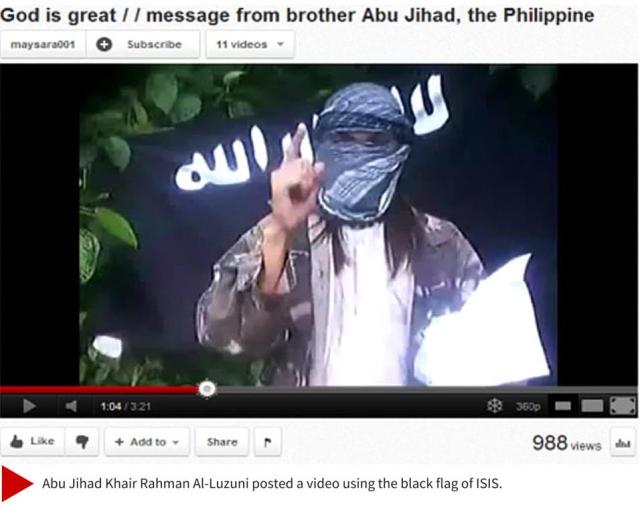
The Abu Sayyaf Group
On 23 July 2014, ASG Commander Isnilon Hapilon posted a video on YouTube to perform a pledge of allegiance to ISIS. Hapilon was indicted in the District of Columbia for his alleged involvement in terrorist acts against American nationals and other foreign nationals in and around the Philippines. The Rewards For Justice Program of the United States Department of State is offering a reward of up to $5 million for information leading directly his apprehension or conviction. Hapilon is an ASG commander operating largely in Basilan of Mindanao. He is directly commanding two main sub-commanders of the ASG in Basilan: Puruji Indama and Marzan Ajilul who are both engaged in kidnap-for-ransom activities. Hapilon is suspected to harboring Malaysian nationals wanted for terrorism offenses by the Malaysian authorities.
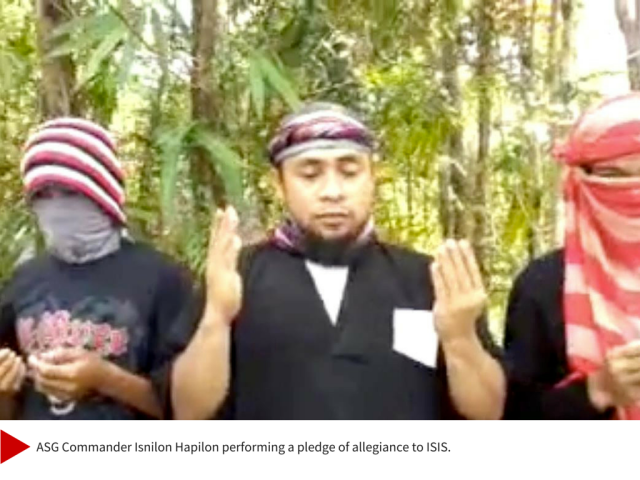
The Bangsamoro Islamic Freedom Fighters
The Bangsamoro Islamic Freedom Fighters (BIFF), a splinter group of the MILF, also pledged its allegiance to ISIS. Umbra Kato, former Commander of the MILF 105th Base Command, founded the BIFF to establish an independent Islamic State in the Southern Philippines. BIFF opposes the peace process between the Philippine government and the MILF. Kato died on 14 April 2015. But he was replaced by a more radical leader, Ismael Abubakar who is a known supporter of ISIS.
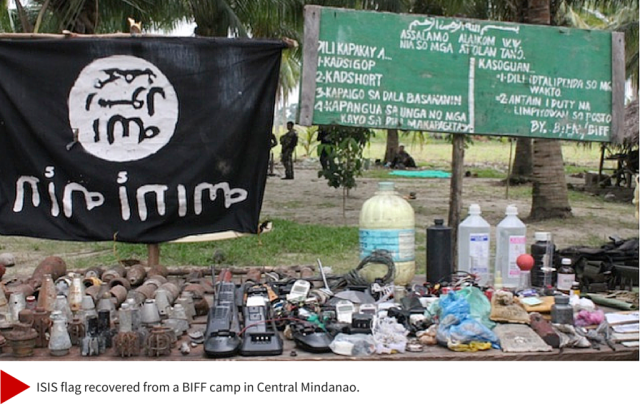
The Ansar Khalifah Sarangani
On 12 September 2014, a group calling itself as Ansar Khalifah Sarangani (AKS) produced its own video pledging allegiance to ISIS. Led by the late Basit Usman, the AKS was more known by its followers as the Jemaah Islamiyah Philippines. Usman was killed by elements of the MILF on 3 May 2015 and had a $1 million reward on his head by the U.S. Rewards for Justice Program. Despite his death, Usman left behind some followers whom he trained in bomb making.
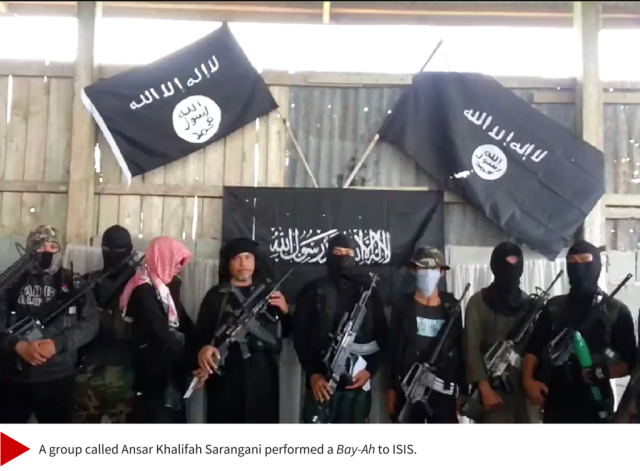
The Khilafa Islamiyah Mindanao
Some of the followers trained by Usman are associated with a shadowy group called Khilafa Islamiyah Mindanao (KIM) organized by a certain Ustadz Humam Abdul Najid sometime in early 2012. The KIM can be considered as the vanguard of ISIS in the Philippines because of its admiration of ISIS black flag. In fact, the KIM is the leading force of the Black Flag Movement in the Philippines (BFMP), which idolizes ISIS. Interestingly, Najid mimics the face of Al-Zarqawi. His followers even call Najid the Al-Zarqawi of the Philippines.
ISIS is posing a grave threat to Philippine security because of the KIM led by Najid. He was responsible for the August 16, 2012 bombing of the Rural Bus Transit in Barangay Guiwan, Zamboanga City. On October 11, 2012, Najid also carried out the bombing of Maxandrea Hotel along JR Borja Street in Cagayan de Oro City. On 24 December 2012, Najid led the bombing of a Pension House in Iligan City as part of the test mission of his trainees. On 16 September 2013, two improvised explosive devices (IEDs) exploded in Cinema 5 of the Gaisano Mall and Cinema 1 of SM Mall Ecoland in Davao City injuring at least six persons. Police authorities suspected the KIM to be responsible for the twin bombing.

ISIS and the Black Flag Movement in the Philippines
Apparent from all the videos showing pledges of allegiance to ISIS was the tantamount display of the black flag associated with ISIS and Al-Qaeda. ISIS was originally the Al-Qaeda in Iraq (AQI) and was an integral part of the Al-Qaeda in Arabian Peninsula (AQAP) operating in the Middle East. Thus, the ISIS use of the black flag was something to do with its Al-Qaeda origin. This black flag is also being used by militants associated with the Al-Qaeda in the Islamic Maghreb (AQIM) operating in Africa.
But Al-Qaeda disowned ISIS because of its very brutal military activities and harsh tactical offensives in Iraq and Syria affecting many innocent civilians. In April 2013, ISIS proclaimed its independence from Al-Qaeda. But ISIS continues to use its own black flag.
The so-called Black Flag Movement is very active in the Philippines. The ASG uses the black flag as a backdrop in their photos and videos every time they demand ransom payments for their kidnap victims. The RSISM and the KIM also use the black flag on its Facebook and Twitter accounts and its various propaganda activities. RSIM leader, Pareja, even created a website, Islamic Emirate of the Philippines, which is strongly akin to ISIS. Pareja is also being suspected of creating another website, The Black Flag Movement, which admires the black flag of ISIS in the Philippines.
Musa Cerantonio, an Australian national who frequently visited the Philippines, was associated with the Black Movement in the Philippines. Like Santos and Pareja, Cerantonio was a Muslim convert influenced by ISIS. The International Centre for the Study of Radicalisation and Political Violence at King's College London published a report in 2014 naming Cerantonio as a "cheerleader” for ISIS. Philippine immigration authorities arrested Cerantonio in July 2014 for violating Philippine immigration rules. But prior to his arrest, Cerantonio used various social media sites while in the Philippines urging Muslim Filipinos to join jihad in Syria and Iraq. In his Facebook account, Cerantonio even posted a map describing the Philippines as the center for ISIS training in Southeast Asia. This map vividly used the black flag of ISIS as its logo. The Philippines deported Cerantonio back to Australia in September 2014.
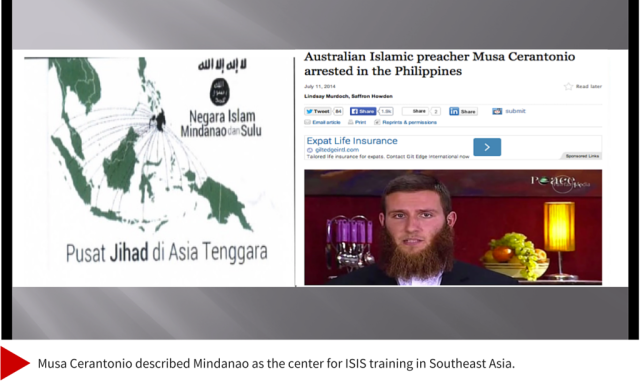
Conclusion
ISIS threat to Philippine security is becoming more and more real rather than imagined. Pledges of allegiance to ISIS by threat groups operating in the Philippines were crystal clear indications of ISIS presence in the country.
During the visit to the Philippines of Pope Francis in January 2015, a Filipino ISIS follower known only by his alias, “Isiah” was sighted in Tacloban City days before the pope visited the place. Tyhoon Haiyan wrecked the city in November 2013 and Pope Francis decided to visit the affected area. Isiah reportedly planned to assassinate Pope Francis while in Tacloban City. Intelligence officials described Isiah as “A Filipino engineer who was recruited and trained in nuclear technology” by ISIS.
Some prominent personalities associated with the ASG, the RSIM and the KIM, among others have shifted their allegiance from Al Qaeda to ISIS. Among these personalities, those associated with the KIM can be considered to be hard-core followers of ISIS in the Philippines.
Hence, the Philippine government has to implement a strong preventive and comprehensive counter-measure before this threat develops into a many-headed monster that is already hard to defeat. Threats posed by self-proclaimed ISIS followers in Mindanao will pose enormous challenges not only for peace and stability of Bangsamoro homeland but also for the security of the entire Philippines.
Rommel C. Banlaoi is the Chairman of the Board of the Philippine Institute for Peace, Violence and Terrorism Research and Director of its Center for Intelligence and National Security Studies. He teaches peace and security studies at the Department of International Studies at Miriam College. He can be reached at This email address is being protected from spambots. You need JavaScript enabled to view it..


